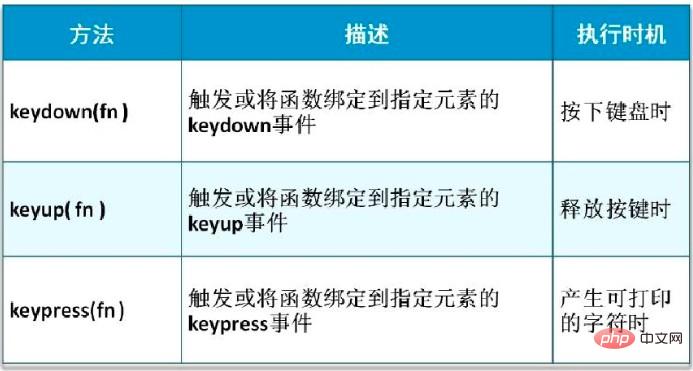What are the commonly used events in jquery
Commonly used events in jquery are: 1. Window events; 2. Mouse events, which are events generated when the user moves or clicks the mouse on the document, including mouse clicks, move-in events, move-out events, etc. ; 3. Keyboard events are events generated every time the user presses or releases a key on the keyboard, including key press events, key release events, etc.; 4. Form events, such as focus() being triggered when an element gains focus Event, the blur() event will be triggered when the focus is lost, and the submit() event will be triggered when the form is submitted.

The operating environment of this tutorial: windows7 system, jquery3.6 version, Dell G3 computer.
1. Classification of jQuery events
jQuery events are encapsulations of JavaScript events. Commonly used events are classified as follows:
1. Basic events
window events . Mouse events. Keyboard events. Form events.
2. A compound event is a combination of multiple events
Hover the mouse cursor. Continuous mouse clicks.
2. Mouse events
Mouse events are events generated when the user moves or clicks the mouse on the document. Commonly used mouse events are:

3. Keyboard events
An event will be generated every time the user presses or releases a key on the keyboard. Commonly used keyboard events are as follows:

4. Form events
When the element gains focus, the focus() event will be triggered. When the element loses focus, the blur() event will be triggered.
The submit() event will be triggered when the form is submitted.

5. Comprehensive example

Requirement description:
- 1. User name When the input box gains focus, the background color of the input box is light blue, and when it loses focus, it returns to the white background color.
- 2. The font becomes thicker when the mouse is moved to the login button, and returns to normal when the mouse is moved out.
3. The form submission event is triggered when the "Enter" key of the keyboard is pressed.
Code:
<!DOCTYPE html>
<html lang="en">
<head>
<meta charset="UTF-8">
<meta name="viewport" content="width=device-width, initial-scale=1.0">
<meta http-equiv="X-UA-Compatible" content="ie=edge">
<title>事件演示示例</title>
<style type="text/css">
#login{
width: 400px;
height: 250px;
background-color: #f2f2f2;
border:1px solid #DDDDDD;
padding: 5px;
}
#login fieldset {
border: none;
margin-top: 10px;
}
#login fieldset legend{
font-weight: bold;
}
#login fieldset p{
display: block;
height: 30px;
}
#login fieldset p label {
display: block;
float:left;
text-align: right;
font-size: 12px;
width: 90px;
height: 30px;
line-height: 30px;
}
#login fieldset p input {
display: block;
float:left;
border: 1px solid #999;
width: 250px;
height: 30px;
line-height: 30px;
}
#login fieldset p input.code{
width: 60px;
}
#login fieldset p img{
margin-left: 10px;
}
#login fieldset p a{
color: #057BD2;
font-size: 12px;
text-decoration: none;
margin: 10px;
}
#login fieldset p input.btn{
background: url("./images/login.gif") no-repeat;
width: 98px;
height: 32px;
margin-left: 60px;
color: #ffffff;
cursor: pointer;
}
#login fieldset p input.input_focus{
background-color: #BEE7FC;
}
</style>
<!--引入jQuery-->
<script src="../jquery-3.3.1.js"></script>
<!--javascript-->
<script>
$(function(){
// 用户名输入框的焦点事件
$("input[name='member']").focus(function(){
$(this).addClass("input_focus");
});
// 用户名失去焦点
$("input[name='member']").blur(function(){
$(this).removeClass("input_focus");
});
// 鼠标移入移出事件
$(".btn").mouseover(function(){
$(this).css("font-weight","bold");
});
$(".btn").mouseout(function(){
$(this).css("font-weight","normal");
});
// 键盘事件,敲击回车键进行表单提交,keyCode的数值代表不同的键盘按键
// js需要区分keyCode(IE)和which(FF)的兼容性,event.keyCode||event.which用来考虑兼容性
$(document).keypress(function(e){
if(e.keyCode==13){
//$("#login").submit();
// 模拟表单提交
alert("触发表单的提交事件");
}
});
});
</script>
</head>
<body>
<form id="login">
<fieldset>
<legend>用户登录</legend>
<p>
<label>用户名:</label>
<input name="member" type="text" />
</p>
<p>
<label>密码:</label>
<input name="password" type="text" />
</p>
<p>
<label>验证码:</label>
<input name="code" type="text" class="code" />
<img src="/static/imghw/default1.png" data-src="images/code.gif" class="lazy" style="max-width:90%" style="max-width:90%" / alt="What are the commonly used events in jquery" ><a href="#" rel="external nofollow" rel="external nofollow" rel="external nofollow" >换一张</a>
</p>
<p>
<input name="" type="button" class="btn" value="登录" />
<a href="#" rel="external nofollow" rel="external nofollow" rel="external nofollow" >注册</a><span>|</span><a href="#" rel="external nofollow" rel="external nofollow" rel="external nofollow" >忘记密码?</a>
</p>
</fieldset>
</form>
</body>
</html>Effect:

[Recommended learning: jQuery video tutorial、webfront-end video】
The above is the detailed content of What are the commonly used events in jquery. For more information, please follow other related articles on the PHP Chinese website!

Hot AI Tools

Undresser.AI Undress
AI-powered app for creating realistic nude photos

AI Clothes Remover
Online AI tool for removing clothes from photos.

Undress AI Tool
Undress images for free

Clothoff.io
AI clothes remover

AI Hentai Generator
Generate AI Hentai for free.

Hot Article

Hot Tools

Notepad++7.3.1
Easy-to-use and free code editor

SublimeText3 Chinese version
Chinese version, very easy to use

Zend Studio 13.0.1
Powerful PHP integrated development environment

Dreamweaver CS6
Visual web development tools

SublimeText3 Mac version
God-level code editing software (SublimeText3)

Hot Topics
 Detailed explanation of jQuery reference methods: Quick start guide
Feb 27, 2024 pm 06:45 PM
Detailed explanation of jQuery reference methods: Quick start guide
Feb 27, 2024 pm 06:45 PM
Detailed explanation of jQuery reference method: Quick start guide jQuery is a popular JavaScript library that is widely used in website development. It simplifies JavaScript programming and provides developers with rich functions and features. This article will introduce jQuery's reference method in detail and provide specific code examples to help readers get started quickly. Introducing jQuery First, we need to introduce the jQuery library into the HTML file. It can be introduced through a CDN link or downloaded
 How to remove the height attribute of an element with jQuery?
Feb 28, 2024 am 08:39 AM
How to remove the height attribute of an element with jQuery?
Feb 28, 2024 am 08:39 AM
How to remove the height attribute of an element with jQuery? In front-end development, we often encounter the need to manipulate the height attributes of elements. Sometimes, we may need to dynamically change the height of an element, and sometimes we need to remove the height attribute of an element. This article will introduce how to use jQuery to remove the height attribute of an element and provide specific code examples. Before using jQuery to operate the height attribute, we first need to understand the height attribute in CSS. The height attribute is used to set the height of an element
 How to use PUT request method in jQuery?
Feb 28, 2024 pm 03:12 PM
How to use PUT request method in jQuery?
Feb 28, 2024 pm 03:12 PM
How to use PUT request method in jQuery? In jQuery, the method of sending a PUT request is similar to sending other types of requests, but you need to pay attention to some details and parameter settings. PUT requests are typically used to update resources, such as updating data in a database or updating files on the server. The following is a specific code example using the PUT request method in jQuery. First, make sure you include the jQuery library file, then you can send a PUT request via: $.ajax({u
 jQuery Tips: Quickly modify the text of all a tags on the page
Feb 28, 2024 pm 09:06 PM
jQuery Tips: Quickly modify the text of all a tags on the page
Feb 28, 2024 pm 09:06 PM
Title: jQuery Tips: Quickly modify the text of all a tags on the page In web development, we often need to modify and operate elements on the page. When using jQuery, sometimes you need to modify the text content of all a tags in the page at once, which can save time and energy. The following will introduce how to use jQuery to quickly modify the text of all a tags on the page, and give specific code examples. First, we need to introduce the jQuery library file and ensure that the following code is introduced into the page: <
 Use jQuery to modify the text content of all a tags
Feb 28, 2024 pm 05:42 PM
Use jQuery to modify the text content of all a tags
Feb 28, 2024 pm 05:42 PM
Title: Use jQuery to modify the text content of all a tags. jQuery is a popular JavaScript library that is widely used to handle DOM operations. In web development, we often encounter the need to modify the text content of the link tag (a tag) on the page. This article will explain how to use jQuery to achieve this goal, and provide specific code examples. First, we need to introduce the jQuery library into the page. Add the following code in the HTML file:
 How to tell if a jQuery element has a specific attribute?
Feb 29, 2024 am 09:03 AM
How to tell if a jQuery element has a specific attribute?
Feb 29, 2024 am 09:03 AM
How to tell if a jQuery element has a specific attribute? When using jQuery to operate DOM elements, you often encounter situations where you need to determine whether an element has a specific attribute. In this case, we can easily implement this function with the help of the methods provided by jQuery. The following will introduce two commonly used methods to determine whether a jQuery element has specific attributes, and attach specific code examples. Method 1: Use the attr() method and typeof operator // to determine whether the element has a specific attribute
 How to build event-based applications using PHP
May 04, 2024 pm 02:24 PM
How to build event-based applications using PHP
May 04, 2024 pm 02:24 PM
Methods for building event-based applications in PHP include using the EventSourceAPI to create an event source and using the EventSource object to listen for events on the client side. Send events using Server Sent Events (SSE) and listen for events on the client side using an XMLHttpRequest object. A practical example is to use EventSource to update inventory counts in real time in an e-commerce website. This is achieved on the server side by randomly changing the inventory and sending updates, and the client listens for inventory updates through EventSource and displays them in real time.
 Understand the role and application scenarios of eq in jQuery
Feb 28, 2024 pm 01:15 PM
Understand the role and application scenarios of eq in jQuery
Feb 28, 2024 pm 01:15 PM
jQuery is a popular JavaScript library that is widely used to handle DOM manipulation and event handling in web pages. In jQuery, the eq() method is used to select elements at a specified index position. The specific usage and application scenarios are as follows. In jQuery, the eq() method selects the element at a specified index position. Index positions start counting from 0, i.e. the index of the first element is 0, the index of the second element is 1, and so on. The syntax of the eq() method is as follows: $("s






